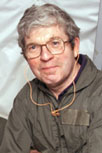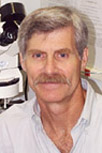Visiting Colloquium Presenters- 2008
 January 17th 2008
January 17th 2008
Amy F. T. Arnsten, Ph.D.
Professor of Department of Neurology
Yale University
Molecular modulation of prefrontal cortical networks: rational basis for mental illness
The Arnsten Lab studies molecular influences on the higher cognitive functions of the prefrontal cortex, with the overarching goal of developing rational treatments for cognitive disorders and mental illness. Research has focused on how the catecholamines, norepinephrine and dopamine, powerfully and dynamically modulate prefrontal cognitive function and physiology through intracellular signaling mechanisms. Our data explain how exposure to stress causes the rapid loss of prefrontal cognitive abilities, and how genetic mutations in molecules that regulate these pathways can lead to symptoms of mental illness. Understanding these mechanisms has led to successful new treatments for patients with prefrontal cortex dysfunction, including medications for Attention Deficit Hyperactivity Disorder, Post-Traumatic Stress Disorder and a potential treatment for schizophrenia and bipolar disorder.
 January 31st 2008
January 31st 2008
James R. Lackner, Ph.D.
Ricklis Professor of Physiology
Brandeis University
Sensory-motor Adaptation to Artificial Gravity
Artificial gravity generated by rotation has been proposed as a way of preventing bone and muscle degeneration during long duration space missions. Exposure to rotation however has undesirable side effects. Body movements in relation to the vehicle generate inertial Coriolis forces that deflect the intended motion. Tilt of the head out of the axis of rotation creates unusual stimulation of the semicircular canals that can be nauseating and disorienting. Such side effects are especially severe at velocities of vehicle rotation greater than 5 rpm. We have found, however, that humans can adapt surprisingly rapidly to rotation rates of 10 rpm, and even higher. When adaptation is complete not only are movements again accurate and head movements no longer disorienting but the movements also feel completely normal. The unusual forces generated by movements are no longer perceived. In a normal stationary environment when individuals make voluntary turn and reach movements, large Coriolis forces are generated on the moving arm. Nevertheless, such movements are accurate and the Coriolis forces are not sensed. Accurate performance means that the central nervous system anticipates and programs motor compensations that precisely cancel the self-generated Coriolis forces. If the relationship between trunk rotation relative to the feet and relative to external space is altered using a servo-controlled rotating platform, reaching movements will become inaccurate and individuals will feel their arm being deviated from its intended path. Similarly, when stationary individuals are experiencing virtual self-rotation, they misreach when pointing to targets. Moreover, it feels to them as if an external force is deviating their arm. In both of these situations, the CNS is compensating inappropriately for anticipated Coriolis forces, in the former case for the wrong magnitudes and in the latter for ones that are absent. Our experiments show that adaptation to a rotating space vehicle is both possible and rapid because we are constantly exposed to Coriolis forces in everyday life. We are our own artificial gravity environments.
 May 15th 2008
May 15th 2008
Jeffrey Corwin, Ph.D.
Professor of Otolaryngology & Neuroscience
University of Virginia
What may account for the absence of regeneration in mammalian ears and its occurrence in non-mammals?
Sensory hair cell loss contributes to permanent hearing and balance deficits in humans and other mammals, but many non-mammalian vertebrates produce hair cells throughout life and can regenerate replacement hair cells in a matter of days. Those forms of growth and recovery occur when supporting cells return to the cell cycle, divide as stem cells, and produce progeny that differentiate into new supporting cells and hair cells. An early postnatal loss of cell production capacity appears to leave mammals vulnerable to permanent hair cell deficits, and this presentation will describe changes in the reinforcement of cell-cell epithelial junctions in vestibular organs from rodents and humans, which correlate with that loss of cell production capacity. Manipulation of related epithelial characteristics has led to the development of methods for culturing avian inner ear cells for months, expanding them to large numbers that can be induced to undergo a mesenchymal-to-epithelial transition that reliably yields new polarized sensory epithelia comprised of supporting cells and numerous hair cells that are crowned by hair bundles which contain a single kinocilium and an asymmetric array of stereocilia. Since vials of these frozen cells can now provide the capacity to produce bona fide hair cells completely in vitro this may allow high throughput screening of pharmaceutical candidates and open new avenues of research aimed at improved treatments for hearing loss and other inner ear disorders.
 October 16th 2008
October 16th 2008
Mark Wallace, Ph.D.
Associate Professor of Kennedy Center for Research on Human Development
Vanderbilt University
Sensory Integration in Navigation and Communication
TBD
 October 17th 2008
October 17th 2008
Charles E. Schroeder
of Nathan Kline Institute for Psychiatric Research
Columbia University
Anatomical substrates and physiological significance of multisensory convergence in primary cortical processing (Sensory Integration Symposium)
TBD
 October 17th 2008
October 17th 2008
Lee M. Miller, Ph.D.
Assistant Professor of Center for Mind & Brain
University of California, Davis
Audiovisual Integration of Speech in Noisy Environments (Sensory Integration Symposium)
TBD
 October 17th 2008
October 17th 2008
Jennifer M. Groh, Ph.D.
Associate Professor of Center for Cognitive Neuroscience
Duke University
Rethinking multisensory integration – going beyond the modular view of the brain (Sensory Integration Symposium)
TBD